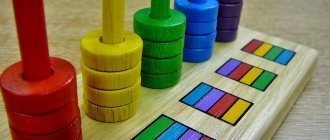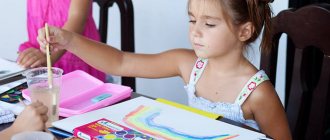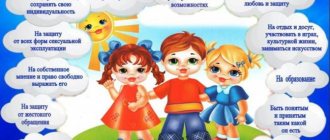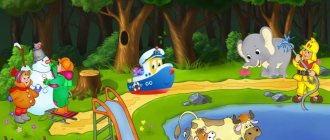Features of imagination development: how does the process occur?
The ability to intentionally create non-standard images in the mind and consciously manage them is not an innate ability of people. It is formed over the years in the process of development.
At each stage of such development, starting from infancy and as they grow older, there are their own characteristics. They depend, among other things, on the physiology of each individual person.
Therefore, we will not go into all these subtleties, but will consider general patterns that influence the work of the imagination.
- The accumulation of ideas through observation , curiosity and perception by the senses. The more such ideas in our minds, the richer and wider the choice for their application in the future.
- The ability to clearly imagine images in all details mentally. This will allow you to focus on the ability to highlight the features of each specific item that represents its value.
- Ability to go beyond limitations. Limitations can be fears, standards of thinking and patterns. So feel free to use your imagination. It helps to better imagine the final result of actions, as well as predict the behavior of others.
You can consciously fill yourself with this by doing simple exercises. We have collected 21 such methods, which we will consider below. We recommend that you read and try to put into practice the proposed means for improving your imagination.
Just don't be alarmed if things don't work out. Each person has a different level of imagination development. If you do these exercises systematically, you will definitely get a shift in your imagination.
Developing speech
Naturally, any person’s speech begins to develop from an early age, when children become familiar with their surroundings. However, it is still possible to help them. The main thing is to do it correctly so as not to harm the child.
There are three generally accepted ways of developing speech: visual, practical and verbal. In preschool organizations, a visual method is most often used, which consists in the teacher himself telling children about the world around them.
So, there is a direct version of this method, which involves visiting excursions or simply pointing at one or another object and pronouncing its name. Another option is indirect, which develops speech by describing certain images or toys. Thus, the skills of coherent speech are improved, and the vocabulary of children is consolidated.
Tools and exercises for developing imagination
The need to develop imagination arises in both adults and children. At the same time, each category requires its own approach. This is due to the characteristics of the psyche and accumulated life experience.
Therefore, we recommend all the methods that will go further for adults. And for children it is better to start the program with the development of perception and the ability to be observant.
Exercise 1. Drawing by dots
For this task we will need a blank sheet of paper and a felt-tip pen, pen or pencil. Then you need to put several dots on it and connect them with lines. You will get a strange figure.
Look and name what you associate it with? The more options, the better for your imagination.
Exercise 2. Association of objects
Look around and select 10 objects from your surroundings. They can be written down on a piece of paper, or they can be recorded visually.
Then, one by one, name the associations that they evoke in you. Associations can be with other objects, events, people or impressions. Try not to limit your imagination.
Exercise 3. Portrait of a literary hero
Take any fiction book and find a description of a literary character. Read and imagine his image. If time permits, then involve drawing. Draw a portrait of the hero on paper.
Exercise 4. Dream online
Everyone is capable of dreaming. The best time to do this is before bed, in the morning or during a walk.
The task is to present the object of your dreams and describe it in 100 words.
Exercise 5. Come up with a continuation of the story
Write a story and think about its title.
“One day I received a letter without a return address. When I opened it, I discovered that...”
Exercise 6. Name possible reasons
Imagine that you are waiting for a bus at a bus stop. It arrives completely empty. Only the driver is there. Write 10 reasons, including the most incredible ones, why there are not a single passenger on the bus?
This technique is aimed not only at developing imagination, but also breadth of thinking and the ability for comprehensive analysis.
Exercise 7. Step by step instructions
The task is to write step-by-step instructions for a dog on the topic “How to jump over a barrier.”
Exercise 8. Doodles
Doodle is a graphic puzzle that has multiple answer options. As a rule, it is depicted in the form of a square with conventional outlines, and the task comes down to seeing different objects in the image . The more creative captions, the better.
There is a second option for working with droodles. Draw them from the squiggle that you see in the picture to a specific drawing that everyone can understand.
Such practical tasks contribute to both the development of spatial imagination and the ability to solve many issues and think outside the box.
Here are some droodles to practice with:
Think about it - what could it be?
Exercise 9. Invented biography
This task is convenient to perform in public places. You need to choose a stranger and try to come up with different details from his biography based on his appearance.
Exercise 10. Uncertain situation
Imagine that you overslept a meeting with an important person. We woke up and immediately received a phone call from him. What will you tell him? It's better to write your speech on paper.
Exercise 11. Essay-reasoning
Take any philosophical topic. For example, “What is happiness?” Write your reasoning on a piece of paper about this.
Exercise 12. Busy schedule
Imagine the situation that you have a lot of free time today and you need to occupy yourself with something. Set a new daily program. List 50-70 options for such activities.
Exercise 13. Three-liter jar
Use your imagination right now and imagine a three-liter jar. What items can fit in it? List as many options as possible.
Exercise 14. The art of painting and music
Here we will talk about musical works or abstract images. Choose what you like and tell us what images you were able to see in them?
Exercise 15. Monologue
this :
A park. It's raining. Some people are in a fussy hurry to take refuge in a warm and dry place. Others walk calmly under an umbrella. And only the homeless cat that sits under a bench in this park has nowhere to run. He was already thoroughly wet and shrank from the cold.
Exercise. Write a monologue from the perspective of a stray cat. What is he experiencing in this situation?
Exercise 16. Fiction
Identifying cause-and-effect relationships is a constant need of our brain. A clear example of an established connection: “If a black cat crosses the road, it will be bad luck.”
Based on how our brains work, come up with fantastical consequences for the following reasons:
- got behind the wheel drunk;
- forgot to turn off the iron;
- left work early.
Exercise 17. “What if?”
Answer the “What if” question:
- Has the electricity disappeared forever? How would people get out of this situation?
- Could you ride on the clouds?
- could a person breathe underwater?
The goal of the method is to express as many ideas and options for the development of events as possible. Initially they will seem superficial. But with practice, your imagination will open up.
Exercise 18. Dubbing actor
This is a very interesting technique that is aimed at developing imagination, resourcefulness and fluency of thinking. To practice, you need to turn on the TV or any video. Turn off the sound and start commenting on what is happening on the screen. For interest, you can check the original.
Exercise 19: Find a Use
To perform this technique, imagine any familiar object, for example, “newspaper”. Come up with a use for it other than the traditional one.
The more options the better:
- You can wrap fish in newspaper;
- crumple it up and dry the shoes;
- use for sun protection and more.
This exercise develops creativity well.
Exercise 20. 3-D images
The technique is to imagine and scroll in your imagination from different angles absolutely any objects that surround us. Carefully consider all the features of the item down to the smallest detail.
Then open your eyes and check what details you missed. Close it again and imagine it with them.
You should perform the exercise until you feel that you have presented the subject clearly, clearly and colorfully.
If you want to practice right now, you can use our list :
mole, binoculars, headphones, kettle, mug, scales, tiger, sunflower, Turk, meat grinder, palm tree, car, refrigerator, collar, rose, boat, shark, violin, cake, shoes.
Toys
Let's look at what kinds of toys there are that develop the imagination.
Lotto with pictures. When taking out a card with a certain image, invite your child to accompany the picture with an interesting, short story. When mom draws the next card, she must also describe the image with a short story. When your child masters this game, you can make it slightly more difficult. Now, when pulling out cards, you need to not only describe the image with a story, but also connect your story and the child’s with each other. Accordingly, the baby will have to continue the mother’s story, pulling out subsequent cards. Puppet show. Both finger toys and those that fit on the hand are suitable
It is important that the child can come up with a story using certain characters. If it’s difficult for a child to come up with a fairy tale right away, then for the first time you can do it instead. A construction set is a great toy that allows you to develop imagination and imagination.
To use this toy effectively, you should not use instructions when building it. There is a wide variety of designers. They come in plastic, metal, and wood. Let the child create using his imagination. Cubes. They are also great for developing imagination. Let your child come up with his own designs. If it’s still difficult for the little one, help. Children's kitchen, household appliances, doctor's kits - all this allows you to create role-playing games, developing the baby's imagination.
Useful feature
The ability to imagine is, of course, necessary for a person. After all, this is his ability to imagine objects or phenomena that are absent at the moment or do not exist in principle, as well as mentally manipulate them in consciousness. This is useful when it is not possible (or necessary) to perform practical actions with these objects in reality. With the help of imagination, you can go to the past or future, imagine the possible result of any plan.
In other words, without this, creative activity is impossible. That is, if people didn’t know how to imagine, we would never know what it is:
- musical works;
- paintings;
- literary works;
- sculpture;
- architecture;
- applied creativity.
The ability to imagine a concept and mentally operate with it is the basis of all scientific discoveries and inventions. It turns out that without imagination the development of humanity is impossible.
Every child has this potential from birth. But its development and improvement occurs only while solving various creative problems. This function develops most actively in children of preschool age - from approximately 4 to 10 years. And if you do not contribute to its improvement during this period, it will go into a passive form.










